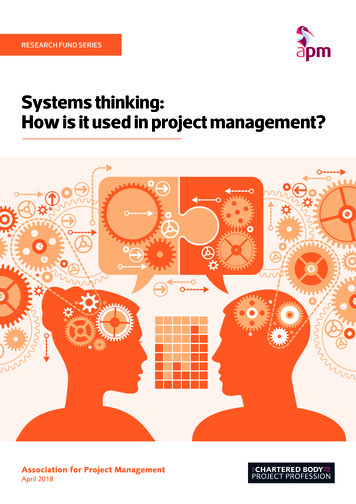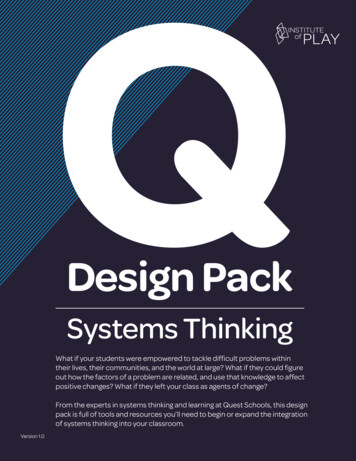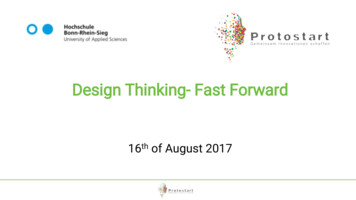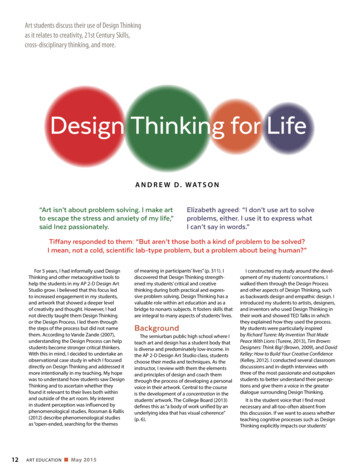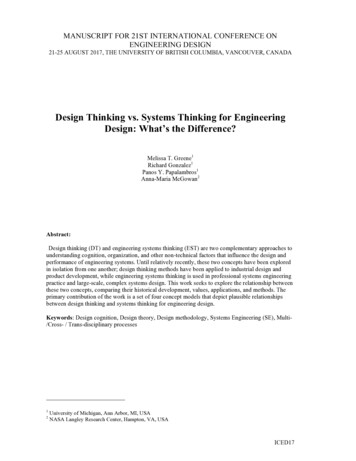
Transcription
MANUSCRIPT FOR 21ST INTERNATIONAL CONFERENCE ONENGINEERING DESIGN21-25 AUGUST 2017, THE UNIVERSITY OF BRITISH COLUMBIA, VANCOUVER, CANADADesign Thinking vs. Systems Thinking for EngineeringDesign: What’s the Difference?Melissa T. Greene1Richard Gonzalez1Panos Y. Papalambros1Anna-Maria McGowan2Abstract:Design thinking (DT) and engineering systems thinking (EST) are two complementary approaches tounderstanding cognition, organization, and other non-technical factors that influence the design andperformance of engineering systems. Until relatively recently, these two concepts have been exploredin isolation from one another; design thinking methods have been applied to industrial design andproduct development, while engineering systems thinking is used in professional systems engineeringpractice and large-scale, complex systems design. This work seeks to explore the relationship betweenthese two concepts, comparing their historical development, values, applications, and methods. Theprimary contribution of the work is a set of four concept models that depict plausible relationshipsbetween design thinking and systems thinking for engineering design.Keywords: Design cognition, Design theory, Design methodology, Systems Engineering (SE), Multi/Cross- / Trans-disciplinary processes12University of Michigan, Ann Arbor, MI, USANASA Langley Research Center, Hampton, VA, USAICED17
1INTRODUCTIONConceptual design of products and systems is a difficult process, during which cognitive, social, andtechnical challenges abound. To address these, formal design engineering methodologies offer theory,process models, and best practices, as well as insights about psychological processes and socialbehaviours that comprise "designerly ways of knowing (Cross, 1982)." Two such approaches, designthinking and systems thinking, have emerged in parallel as methods for tackling these "wicked" designproblems in diverse settings (Rittel and Webber, 1973; Checkland, 1981; Clarke, 2000). Design thinkingand systems thinking frameworks are useful for anticipating and addressing emergent features ofproducts, systems, and organizations (Plattner et al., 2014; McGowan, 2014; Viswanathan and Linsey,2014; Davidz and Nightingale, 2008), and have additional applications in engineering design (Forrester,1961; Frank, 2000; Dinar et al., 2015; Watson et al., 2014; McGowan et al., 2017), management andorganization (Senge, 1990; Checkland, 1981, 1999), pedagogy (Dym et al., 2005; Lammi and Becker,2013), and other contexts.While domain independence is considered an advantage of the design thinking and systems thinkingframeworks, divergent definitions and approaches have created an ambiguous literature. At its worst,this situation has led to the dismissal of these concepts as "buzzwords," devaluing the empirical evidencethat supports them (Patel and Mehta, 2016; Dinar et al., 2015; Shah et al. 2012; Jaradat, 2015).Additional work is necessary to address this criticism, and to integrate and strengthen the existing bodyof knowledge. Until recently, design thinking and systems thinking have been explored mostly inisolation from one another. Systems thinking is sometimes described as a component of design thinking(Long, 2012), sometimes as separate but related to design thinking (Patel and Mehta, 2016), and issometimes not described alongside design thinking at all. Likewise, references to design thinkingresearch are not often found in systems engineering research on systems thinking or systems design.Understanding how system designers think is key to advancing systems engineering methods, tools, andoutcomes (Griffin, 2010; Watson et al., 2014). Design engineering researchers in academia havesuccessfully adapted formal cognitive science approaches to study designer thinking (Dinar et al., 2015).Systems engineering researchers in industry and government have broadly identified skills, attitudes,and behaviours necessary for complex systems design (Frank, 2006; Williams and Derro, 2008; Davidzet al., 2005; Rhodes et al., 2008), but existing cognitive approaches are limited (Greene andPapalambros, 2016). Studying the relationship between designer thinking and systems thinkingparadigms could be useful for addressing this gap, and for identifying other areas in which onemethodology might be improved by the knowledge of the other.This work makes a first attempt at comparing research perspectives on engineering design thinking (DT)and engineering systems thinking (EST). Its purpose is neither to provide a complete analysis of theliterature nor to propose a new definition of either concept. Rather, it is intended to serve as a primer onthe history, values, applications, and methods of each approach and to relate them to one another.Comparing the historical context and values underlying each approach is useful for explaining whydesign thinking and engineering systems thinking evolved independently into what they are today.Exploring contemporary applications and methods is useful for identifying opportunities to shareknowledge and tools between communities in future research efforts.The rest of the work is structured as follows to achieve these objectives. Sections 2 & 3 provide a briefintroduction to relevant literature from the design engineering and systems engineering communities.The literature review is organized by high-level themes history, values, applications, and methods thatrecur throughout. Section 4 suggests several different ways to compare design thinking and systemsthinking using these themes, represented by "concept models" that visually position DT and EST themesrelative to one another. The themes and concept models proposed are coarse, and the authors do notsuggest any single "correct" model for the relationship between DT and EST. Rather, these modelsrepresent several plausible theories about the relationship between design thinking and systems thinkingmethodologies, and are meant to encourage additional discourse and collaboration between the designand systems engineering communities.ICED17
2DESIGN THINKING & THE SCIENCE OF DESIGN2.1 A brief history of design thinking researchRapid technological development throughout the twentieth century generated a need for formalacademic study of "the science of design (Simon, 1969)." Two important periods in the modern historyof design science are identified by Cross (1982). The first, the "design products movement" of the 1920s,sought to "produce works of art and design based on objectivity and rationality;" that is, on the valuesof science. The second, the "design methods movement" of the 1960s, sought to establish designprocesses—in addition to the products of design—based on similar scientific principles. Despite somebacklash against design methodology in the 1970s, the tradition continued to flourish in engineering andindustrial design, and several prominent academic journals for design research, theory, and methodologyemerged during the 1980s and 1990s.Design methodology is defined by Cross (1982) as "the study of the principles, practices, and proceduresof design" and "includes the study of how designers work and think." Over the past several decades,engineering researchers have successfully leveraged cognitive and social science approaches to studyhow designers think through engineering design problems, exploring a breadth of topics includingcreativity, ideation in early conceptual design, the role of analogies in creative problem solving,differences between novices and experts, and strategies for overcoming fixation and mental blocking.Verbal protocol analysis, cognitive ethnography, controlled laboratory experiments, and other formalmethods from cognitive science have been rigorously applied to the study of designer thinking inengineering (Dinar et al., 2015; Shah et al., 2012).Results of these studies and others suggest that design thinking approaches use solution-based methodsto explore human-centred values throughout the engineering design process. This finding is reflected inmany applications of design thinking: prototyping, a solution-based method, is often cited as a usefulway to encourage inspiration, ideation, and organizational learning, all human-centred values (Brown,2009; McGowan et al., 2017). Specific applications and methods for design thinking will be brieflydescribed in the following sections.2.2 Applications of design thinking researchMany applications of the design thinking framework exist in the literature and in practice. Examplesinclude Herbert Simon's design thinking process (1969), which suggests seven stages of design thinkingfor product design, including defining the problem, researching, ideating, prototyping, choosing asolution, implementing the solution, and learning. Plattner, Meinel and Leifer (2011) propose a fivestep version of the design thinking process that includes redefining the problem, need finding andbenchmarking, ideating, building, and testing. International design and consulting firm IDEO applies afour-phase process that includes gathering inspiration, generating ideas, making ideas tangible, andsharing your story (Brown, 2009).While each interpretation differs slightly from the others, important foundational values of designthinking persist. First, design thinking is solution-based, and most design thinking methods includeprototyping and iteration phases. These solutions are human-centred products or services, developedwith designers' personal experiences, intellect, empathy, and understanding. Likewise, the designthinking process itself is human-centred, offering methods for inspiration, ideation, and learning todesigners (Brown, 2009). Design thinking has been described as a "high order intellectual activity" that"requires practice and is learnable" (Plattner et al., 2011). This description is supported by findings incognitive psychology. Example methods for studying design thinking are discussed in the followingsection.2.3 Methods: Studying designer thinking and design cognitionAs previously described, empirical studies of designer thinking are abundant, having maturedsubstantially since the early 1980s. Contemporary applications of the term "designer thinking" generallyrefer to the study of "cognitive processes and strategies employed by human designers working ondesign problems (Dinar et al., 2015)." These processes are explored through case studies, think-aloudprotocols, controlled experiments, psychometric measurement, and, more recently, throughphysiological measurement techniques such as functional magnetic resonance imaging (fMRI). Popularresearch topics in design cognition include the role of sketching and visual representation, the use ofICED17
analogies, methods for fostering creativity, ideation, and overcoming blocking, approaches for balancingdivergent and convergent thinking, and elucidating differences between expert and novice designers. Adetailed discussion of these studies and their contributions is beyond the scope of this work. However,a comprehensive review of empirical studies of designer thinking is provided in the paper by Dinar etal. (2015).A critical point here is that “thinking” research in the design engineering tradition has successfullyintegrated theory and methods from cognitive and other social sciences. Studies on engineering systemsthinking, a similar concept developed for application in systems engineering organizations, might lookto advance in a similar way. Only recently have research efforts expanded to include non-engineeringfactors such as design cognition in the analysis of engineering systems design (Davidz and Nightingale,2008; Griffin, 2010; Frank, 2012). The following section describes the history of the EST concept,tracing its evolution from a physics-based modelling method to the more interdisciplinary approachobserved in practice today. Contemporary values, applications, and challenges are also discussed.3THE "SYSTEMS APPROACH" TO COMPLEXITY MANAGEMENT3.1 A brief history of the systems approachThe history of the “systems approach” for dealing with design complexity is long and diverse. Thefollowing section provides a brief overview of several major schools of systems theory, beginning withLudwig von Bertalanffy’s General Systems Theory (1940). von Bertalanffy’s work was quicklyexpanded to describe cybernetic systems (Wiener, 1948) and dynamic systems (Forrester, 1961), andhas also informed traditional operations research, systems engineering, and management science(Checkland, 1981). Later work examined the application of general systems concepts to human socialsystems. While general systems theory was somewhat useful for analysing social and organizationalsystems, traditional physics-based models did not always adequately represent human factors thatinfluence system performance (Forrester, 1994). These findings prompted the development of “softoperations research (OR)”—a collection of methods 'designed to help with the understanding,clarification, and communication of problems' in industrial engineering and design. Engineering systemsthinking is considered a method for soft OR (Forrester, 1994). Because EST evolved in the OR tradition,its empirical study has been limited to the perspectives and methods of systems engineering,management science, and quantitative decision-making, with limited insights from cognitive and othersocial sciences.3.1.1 General systems theory & cyberneticsThe term “systems theory” was coined by Ludwig von Bertalanffy in 1937 and describes theinterdisciplinary study of systems in general. Systems theory emerged as an attempt to uncover patternsand principles common to all levels of all types of systems, again with an emphasis on generality. Theprimary goal in developing systems theory was to provide a useful framework for describing a broadrange of systems using the same terminology, in contrast to existing discipline-specific systems modelsin biology, engineering, and psychology (von Bertalanffy, 1940).A central tenet of systems theory is self-regulation, and systems theory is often applied to describesystems that self-correct through feedback. These types of systems are found in nature, in local andglobal ecosystems, and in human learning processes at both the individual and organizational level.Early work in self-regulating systems eventually led to the development of cybernetics – the formalstudy of communication and control of regulatory feedback (Wiener, 1948). Cybernetics offersapproaches for exploring natural systems, mechanical systems, physical systems, cognitive systems, andsocial systems; cybernetics is applicable in the analysis of any system that incorporates a closedsignalling loop. While the cybernetics framework can be applied to analyse non-engineering systems,engineering theory and methods are still used to represent the system.Systems dynamics, a related field pioneered by Jay Forrester at MIT, emerged in the mid-1950s asapplication of electrical control theory to the analysis of business systems. Forrester developed amathematical modelling technique to help corporate managers improve their understanding of industrialpractices. By simulating the stock-flow-feedback structure of an organization, Forrester demonstratedthat instability in organizational employment was due to internal structure of the firm, and not to anexternal force such as a business cycle (Forrester, 1961). Forrester’s work on applied system dynamicsmarked a major paradigm shift in engineering by successfully demonstrating that mathematical modelsICED17
are useful for representing, understanding, and predicting outcomes for non-technical systemsengineering problems.3.1.2 From 'system dynamics' to 'systems thinking'System dynamics is a foundational method in systems engineering (SE)—an interdisciplinary field offormalized approaches for designing and managing large-scale, complex engineered systems (LSCES)throughout the life cycle. Like design science, the need for systems engineering arose with the increasein complexity of military-industrial systems in the 1940s: as projects increased in size and scope,computational tools for modelling and simulation, requirements analysis, reliability, logistics,coordination, scheduling etc. were necessary for successful system design, implementation, anddecommission. Systems engineering methodology offers a process for technical management ofLSCES— sophisticated quantitative techniques are used to organize and coordinate work activities,evaluate technical systems interactions, and assure system quality and performance. To address humanfactors that influence LSCES design, systems engineering has drawn from operations research andmanagement science to develop mathematical models of human performance. Examples of classicalquantitative approaches to management include Markov analysis; linear/dynamic programming;decision theory; and game theory, among others.Systems engineers are well-trained to manage technical system consolidation, but the associated changesbetween social and organizational units are more difficult to govern in practice. Existing analyticalmethods from hard OR methodology are inapplicable or ineffective for solving this problem (Forrester,1994). Nonetheless, systems engineers are expected to play ambidextrous roles and have theprofessional responsibility of “systems thinking,” i.e., serving as big picture “visionary designers” whomanage technical as well as social and organizational constraints in dynamic environments (Brooks etal., 2011). The complexity of this task and its implications for system performance, cost, and scheduleled to the development of soft operations research— an extension of traditional operations research thatplaces less emphasis on mathematical modelling of business and social systems and more on thoroughlydefining system boundaries and problems, resolving conflicting viewpoints, and reaching consensus onfuture action (Forrester, 1994). Soft OR methods such as ST characterize systems on a variety ofqualitative dimensions — e.g., physical vs. social, causal vs. probabilistic, degree of complexity, orsusceptibility to control— and utilize discussion and intuition rather than quantitative methods toanalyse systems engineering and design processes (Forrester, 1994).3.2 Engineering systems thinkingUnderstanding how systems engineers evaluate technical and social relationships—and leverage thisinformation to successfully design and manage complex systems—is a challenge in modern systemsengineering practice. Research efforts in recent decades have explored this activity, attempting toelucidate both individual traits, skills, and attitudes as well team properties that contribute to the“capacity for engineering systems thinking (Frank, 2000, 2006, 2012; Williams and Derro, 2008; Brookset al., 2011).”Several general trends in the study of EST can be identified, and conceptual themes are described inmore detail in Sections 3.3. First, it is important to note that engineering systems thinking is primarilystudied through behavioural observation and defined in behavioural terms in the literature. One notableexample is a 2008 study conducted by NASA's Office of the Chief Engineer, in which "highly-valued”systems engineers—those identified by NASA centres as “go-to” people with regards to systemsengineering— were interviewed, shadowed, and observed, and findings summarizing their behaviourwere organized and distributed as an interagency report (Williams and Derro, 2008). The study resultedin rich descriptions of individual attitudes, problem solving strategies, technical acumen, and systemsthinking capabilities required to do systems engineering at the highest level, and described leadership,communication, and other social skills as equally important for systems thinking and systemsengineering. These findings are mirrored in several other studies from industry and academia (Davidzet al., 2005; Rhodes et al., 2008; Frank, 2000, 2006, 2012).Second, practicing engineers and engineering researchers are beginning to acknowledge the need for amore rigorous interdisciplinary framework for EST, to understand the social and psychologicalunderpinnings of EST behaviours. Frank (2006, 2012) describes systems thinking as “a high-orderthinking skill,” and suggests several cognitive processes that might facilitate systems thinking. Work byRhodes and colleagues Lamb, Nightingale, and Davidz (2008) suggests that enabling systems thinkingICED17
is a critical step in advancing the development of senior systems engineers, at the same time recognizingthat fundamental questions remain about how systems thinking develops in engineers. The authorsdescribe “how” to do systems thinking using tools, methods, models, and simulations, reflecting thetraditional systems engineering approach, but identify other important enablers to the development ofsystems thinking such as experiential learning, education, interpersonal interactions, and training in asupportive environment. The authors also identify some individual cognitive and social processes atwork, and recommend additional inquiry in this area.3.3 Values, applications, and methods in EST researchEngineering systems thinking shares a foundation with systems science; thus, values and applicationsbear strong resemblance to those of general systems theory, cybernetics, and systems dynamics. TheEST framework posits that a system is composed of parts, the system is greater than the sum of its parts,and all parts of the system are interrelated. Systems receive inputs from the environment, executeprocesses that transform these inputs into outputs, and send these outputs back into the environment infeedback loops. Systems are dynamic and complex, interactions may be difficult to identify or quantify,and emergence is common. Like the earlier approaches, engineering systems thinking is system-centred,i.e., is used for conceptualizing systems, their individual components, and interactions between thosecomponents, to help designers anticipate emergent features and design robust and resilient systems.Contemporary research in EST seeks to make the approach more human-centred. Successful engineeringsystems thinkers are consistently recognized as being good leaders and communicators and as naturally"curious" or "innovative." Studies suggest that systems thinkers can see and define boundaries;understand system synergy; and balance reductionist and holistic viewpoints. They think creatively,overcome fixation, and tolerate ambiguity. ESTs ask "good questions"; can understand new systems andconcepts quickly; can consider non-engineering factors that influence system performance; andunderstand analogies and parallelism between systems (Frank, 2012; Williams and Derro, 2008; Davidzand Nightingale, 2008; Davidz et al., 2008; Rhodes et al., 2008; McGowan, 2014). While these humancentred values are described at a high level in EST research, few formal methods exist in systemsengineering for applying or studying them with precision.4"CONCEPT MODELS" FOR COMPARING DESIGN THINKING ANDENGINEERING SYSTEMS THINKING RESEARCHPrevious sections described design thinking and engineering systems thinking using four generalthemes: history, values, applications, and methods. This section organizes these themes into "conceptmodels" that visually represent different perspectives on the relationship between design thinking andengineering systems thinking. The first model, called the Distinctive Concept Model, positions DT andEST as separate concepts, each with a unique history, set of values, practical application, and methods.The second model, the Comparative Concept Model, suggests that DT and EST are similar underlyingconcepts with different applications and methods. The third model, the Inclusive Concept Model,describes engineering systems thinking as a specific application of design thinking, in which designthinking principles, methods, and processes are applied to complex systems design problems. The finalmodel, the Integrative Concept Model, suggests that design thinking might be the critical skill for designat both the product and system level, and that EST might not be practically distinguishable from DT.Again, these models do not suggest any single "correct" representation of the DT/EST relationship.Additional work will be required to make definitive claims.4.1 The Distinctive Concept ModelThe distinctive concept model of design thinking and engineering systems thinking describes two uniqueconcepts with different histories, values, themes, and applications (Fig. 1). This model suggests that DTand EST were developed for different purposes, with different guiding principles.ICED17
Figure 1. Distinctive concept model of design thinking and engineering systems thinking. DT/ESTare distinct concepts, with different histories, approaches, and goalsDesign thinking has origins in psychology, industrial design, and product development, and is a methodfor generating innovative, user-centred products and services. Empathy is a key driver of the designthinking process. Systems thinking, on the other hand, originated from cybernetics and operationsresearch and is intended to capture stock and flow structures and feedback loop dynamics. It is systemfocused and used for identifying potential interactions between system elements that might result inunintended system performance. Put succinctly, the goal of design thinking is to create innovative, userfriendly products and services. The goal of systems thinking is to uncover as many relevant factors andinteractions between system elements as possible, so that systems can be designed to be resilient androbust.4.2 The Comparative Concept ModelA second conceptualization of design thinking and engineering systems thinking positions the twoconcepts as distinct, but with several major overlaps (Fig. 2). While DT and EST have different origins,applications and approaches, both require a similar cognitive skill set in practice: design thinkers andengineering systems thinkers alike must be creative, flexible, curious, and emotionally intelligent.Design thinkers and engineering systems thinkers both utilize divergent and convergent thinkingstrategies, use analogical, visual, and spatial reasoning, and embrace ambiguity and emergence.However, design thinking is a somewhat more linear and bounded process, in that it leads to concrete,physical prototypes. Systems thinking is more cyclical and abstraction-driven, and does not emphasizetangibility through prototyping in the same way that design thinking methodology does.Figure 2. Comparative concept model of design thinking and engineering systems thinking.ICED17
Underlying mechanisms are similar, but concepts have different applications and utilizedifferent methods4.3 The Inclusive Concept ModelThe inclusive concept model suggests that engineering systems thinking might not be a standalonemethodology, but rather the specific application of design thinking principles to the design of largescale, complex engineering systems such as software enterprise systems, aerospace vehicles, or nuclearpower stations (Fig. 3). DT and EST are both approaches for addressing design complexity, definingand solving wicked problems, and understanding the role of cognitive and social processes on systemdesign and performance. Systems thinking has been described as a necessary skill for design thinking(Long, 2012). The key distinction here is the emphasis placed on abstraction, interdependence, andemergence in EST, versus tangibility, prototyping, testing, and redesign in DT.It is important to note that EST is included as a subset of DT and not the other way around. This is partlybecause design thinking has an established interdisciplinary methodology, certifications, short courses,etc., compared to the more casual exploratory studies and descriptions of EST skills. Likewise, systemsthinking is sometimes mentioned in the design thinking literature as a requisite skill for design thinking,while there is little mention of design thinking in the engineering systems thinking literature. However,an inverse form of this model is plausible as a “systems view” is required for user-centred design.Figure 3. Inclusive concept model of design thinking and engineering systems thinking. ESTis represented as the specific application of design thinking principles to the design of largescale, complex engineered systems4.4 The Integrative Concept ModelThe final model suggests that these philosophies might be better understood as part of a singleoverarching framework with distinctions for product design, LSCES design, and the design of services(Fig. 4). Design thinking could be the fundamental skill required for design across all contexts and levelsof complexity; engineering systems thinking might not be distinguishable from design thinking inpractice. It is plausible that DT and EST evolved as separate concepts only because of a methodologicalgap between academic design research and the practice of professional systems engineering.ICED17
Figure 4. Integrative concept model of design thinking and engineering systems thinking.Despite historical/ conceptual differences, DT and EST utilize the same cognitive processesand have the same practical application5CONCLUSIONS AND OPPORTUNITIES FOR FUTURE INQUIRYDesign thinking and engineering systems thinking are similar frameworks for exploring principles andprocesses of engineering design. Further research is required to fully understand the intricacies of DTand EST, and to draw definitive conclusions about the relationship between the two. The primarycontribution of this work is that it represents an early attempt at comparing perspectives on engineeringdesign thinking and engineering systems thinking. Its purpose was not to provide a complete analysis ofthe literature nor to propose a new definition of either concept, but to instead serve as a reference
industrial design, and several prominent academic journals for design research, theory, and methodology emerged during the 1980s and 1990s. Design methodology is defined by Cross (1982) as "the study of the principles, practices, and procedures of design" and "includes the study of how


